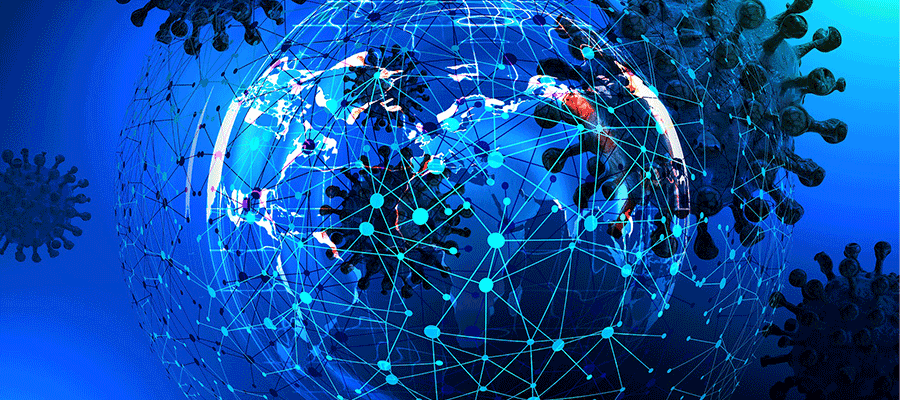
While the whole world is joining forces to fight the COVID-19 pandemic, we would like to take a minute to discuss how IoT technology can be used to detect, track, and help prevent this deadly virus from spreading. We need to learn from our successes and mistakes in dealing with this pandemic so that we can be better prepared for future outbreaks of this nature.
Tracking and Privacy
China and South Korea are already tracking the movement of and monitoring people who have been in contact with carriers of this potentially deadly disease. In the past, there has been resistance to these kinds of draconian measures that infringe on the individual’s right to privacy. In 2011, for example, an app called FluPhone was developed at Cambridge University to track where potential flu carriers had been and with whom they had been in contact. However, only 1% of the potential flu carriers agreed to use the app. It seems that the desire for privacy and for avoiding social hazing was stronger than helping to slow down or even stop the annual flu epidemic, which each year kills 12,000 to 60,000 people in the USA alone.
One possible solution is to have such an app built into all phones, placing the good of all over the privacy rights of the individual. [1] The Chinese ecommerce giant Alibaba has developed the Alipay Health Code app, which every Chinese person must install on their phones. The app uses a three-color code to tell the user if they are allowed free movement in public spaces and on public transportation (green), limited movement (yellow), or total quarantine (red). There are checkpoints throughout China where authorities can demand to see one’s health status. But this app alone is not the silver bullet for containing a pandemic. Aside from concerns about invasions of privacy, there have also been complaints about false readings that have prevented people from returning home from work or legitimate errands. [2]
IoT research specialist Dilip Sarangan suggests a more robust solution. He says that in the best of all possible worlds, enterprises, cities and nations would collectively create a worldwide network of IoT sensors to detect Coronavirus and other similar outbreaks—with detection being the first crucial step in controlling a pandemic. He notes, however, that the chances of countries working together in such a manner are currently nil, and he calls on agencies such as the World Health Organization to start pressuring countries to implement such devices at the initial outbreak of infectious diseases, before they become global emergencies. [3]
Working From Home
There is a new acronym in the workplace: FOG, Fear of Going-to-work. The IEEE reports that since March 1st the number of people in the high-tech sector that are scared to go to their place of work has spiraled upward dramatically and presently stands at more than three quarters of the work force. [4]
As a result, more and more people are working from home. However, there is a fear that the ever-increasing number of IoT devices in the household are easy targets for hackers, who can use them as gateways to undermine the security of the larger systems they connect to. Some simple precautions, however, can stymie potential IoT hackers. First, if you set up the network to which your home IoT devices are connected as a VPN, data can be received and transmitted securely. In addition, you should de-centralize your passwords, using a unique and strong password for each website and service. [5]
A Smart Device That Helps Fight Corona virus
A new start-up, Soapy Care, has developed what they call “smart sinks.” With the tag line “Your hygiene is in your hands”’, these stand-alone micro-stations (kind of like water coolers) use IoT sensors to dispense the exact amount of soap or sanitizer that should be used, as well as the amount and temperature of water needed to properly wash your hands. With different settings recommended for the home, restaurants, day care or senior centers, these hand-washing stations ensure that no one takes any shortcuts on their, and ultimately your, hygiene. Soapy Care’s systems can already be found in the US, Africa and Asia, and since the COVID-19 outbreak, their phones haven’t stopped ringing. [6]
Final Note
We are all going through hard times. The bottom line seems to be prudence and common sense, as well as not to let yourself feed into the spiral of panic. The lessons we learn from this pandemic can hopefully be put to good use to develop IoT-based technologies and systems that will help us better manage the next one.
We at Arad wish everyone good health and a quick end to this crisis. And now I’m off to wash my hands.
References
[1] Will Knight, Phones could track the spread of Covid-19. Is it a good idea?, March 15, 2020
[2] Mark Andrejevic, The new transparency: smartphone, data tracking and Covid-19, March 09, 2020
[3] DQIndia Online,Can Coronavirus like outbreaks be controlled with IoT, February, 6, 2020
[4] Kurt Marko, Coronavirus is exploding the home workforce, March 11, 2020
[5] Chandu Gopolakrishnan, Covid-19 boosts remote work, security concerns, March 04, 2020
[6] Adi Pick, This startup wants to fight Coronavirus with soap and water, March 09, 2020